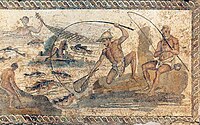
Photo from wikipedia
Abstract Old‐growth forests host a rich diversity of invertebrate assemblages. Among them, saproxylic insects play a fundamental role in the nutrient cycle and ecosystem functioning. In these environments, coevolution between… Click to show full abstract
Abstract Old‐growth forests host a rich diversity of invertebrate assemblages. Among them, saproxylic insects play a fundamental role in the nutrient cycle and ecosystem functioning. In these environments, coevolution between insect and plants have reached a stable equilibrium over millions of years. These delicate ecosystems are threatened mainly by habitat loss and fragmentation, and to date, they have to face the new “plastic threat.” Plastics are widespread in all biomes and ecosystems accumulating throughout the years due to their low degradation rate. Once accumulated, large pieces of plastics can be degraded into smaller particles, the latter representing a great threat to biodiversity and ecosystem health, producing detrimental effects on biota. Since the effects of plastics on terrestrial systems remain largely unexplored, this study aimed at contributing to increasing the knowledge on the interaction between plastics and terrestrial biota. We put our emphasis on the novel and broad topic of plastic degradation by saproxylic beetle larvae, describing how they fragmented macroplastics into microplastics. To investigate whether saproxylic cetonid larvae could degrade expanded polystyrene, we performed an experiment. Thus, we put larvae collected in the field in an expanded polystyrene box. We observed that larvae dug in the thickness of the box fragmenting macroplastics into microplastics and producing a total of 3441 particles. Then, we removed the larvae from the EPS box and isolated them in glass jars filled with natural substrate. The substrate was checked for EPS microplastics previously ingested and now egested by larvae. Additionally, we pointed out that plastics remained attached to cetonid larvae setae, with a mean number of 30.7 ± 12.5 items. Although preliminary, our results highlighted that microplastics attached to saproxylic cetonid larvae might be transported into habitats and transferred along the food web. In conclusion, plastic pollution might affect vulnerable species and ecosystem services representing a risk also for human health.
Journal Title: Ecology and Evolution
Year Published: 2022
Link to full text (if available)
Share on Social Media: Sign Up to like & get
recommendations!